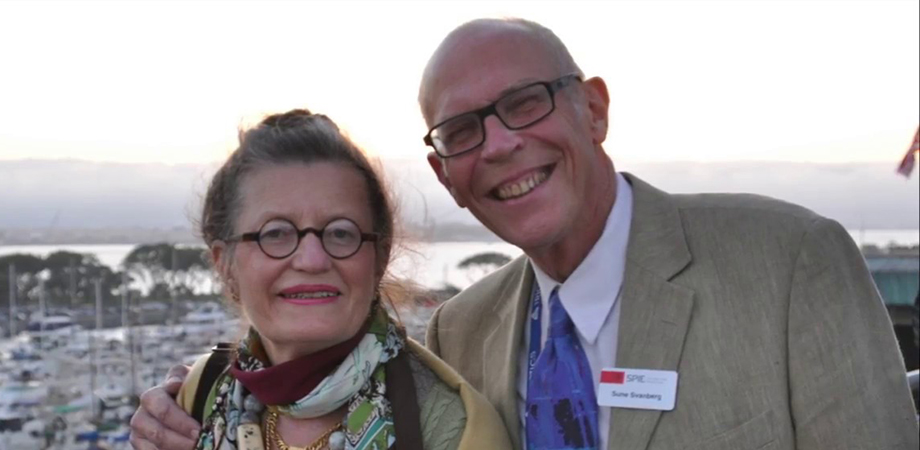Optics and Biophotonics in Low-Resource Settings
Photonics for a Better World.

The SPIE conference "Optics and Biophotonics in Low-Resource Settings" features presentations on technologies such as smartphone-based optical instruments; low-cost, mobile spectral imaging; and OCT instrumentation for use in technically under-developed areas of the world. Here, Ford Burkhart describes two talks from the 2018 SPIE Photonics West conference.
Spectroscopy solutions assist African network
Very-low-resource settings for photonics might be illustrated by the African sites where Katarina and Sune Svanberg work, where many see a doctor once a year, if they're lucky.
They say new clinics might be created there with instruments costing as little as $10,000 each, with molecular spectroscopy employed to save many from malaria. A $50,000 laser system, for example, could be crucial in Africa, where a million people die a year following mosquito bites. 
 The Svanbergs, professors at Lund University in Sweden and South China Normal University in China, described their work in a crowded Saturday keynote talk on "Spectroscopic applications for low resource environments," at SPIE Photonics West.
The Svanbergs, professors at Lund University in Sweden and South China Normal University in China, described their work in a crowded Saturday keynote talk on "Spectroscopic applications for low resource environments," at SPIE Photonics West.
In the areas where "resources are almost zero" they strongly advocate local capacity building, bringing in "top notch equipment," rather than taking Africans to Sweden or the US, which would simply cause a "brain drain," they said in a joint talk. That way, they said, the West can "help scientists there to help themselves."
Sune Svanberg, who is the atomic physics division chair at Lund University, said SPIE had been an important partner and supporter of their 25 years collaborating with scientists in "some of the poorest countries of the world."
Early programs made use of 780nm diode laser spectroscopy lifted from CD players, and compact fiber-optic fluorosensors, with some of the Svanbergs' students building such equipment for use in their labs. They've trained local staff to use compact multi-color UV-LED fluorosensors, and employ GASMAS, for gas in scattering media absorption spectroscopy, technology at five sites.
Their efforts, with many colleagues, to hold workshops in Africa have paid off with formation in 2010 of the African Multi-Spectral and Imaging Network (AFSIN). Along with local researchers in Ghana, Ivory Coast, Senegal, Mali, Togo, Cameroon, Kenya, and Burkina Faso, they put multispectral microscopes to work on malaria diagnostics at six sites, each created for less than $10,000.
In Nairobi, Kenya, remote monitoring of water pollution was their focus, with labs incorporating Chinese CW laser systems, each costing less than $20,000.
Katarina Svanberg, a leading oncologist working with medical lasers, described their work with the environment, ecology, agriculture, food safety, and biomedicine issues in Africa, using principles that they teach at the Centre for Optical and Electromagnetic Research, at South China Normal University in Guangzhou.
She helped start a biophotonics summer school in Senegal, where patients from the "Blue Tribe" walked for days to access clinical treatment.
Her group trained doctors and gave them needed instruments including fluorosensors to continue the treatments working in Dakar, Senegal, with Sheikh Anta Diop University.
With cervical cancer accounting for 40 percent of female cancer, mostly from viral infections, Katarina Svanberg called for more remote use of photodynamic therapy (PDT). "We could use PDT therapy for cervical cancer and treat patients out where they live, not needing to have them in the hospital."
Optics aids malaria diagnosis in Rwanda
In Rwanda, a US student-designed photonics technology will soon lead to instant, on-the-spot malaria diagnosis, and treatment as needed - helping authorities cope with the proliferation of drug-resistant strains of the disease.
 Gerard Coté described the work, at a new center called "PATHS-UP", short for Precise Advanced Technologies and Health Systems for Underserved Populations, during the BiOS conference on Optics and Biophotonics in Low-Resource Settings.
Gerard Coté described the work, at a new center called "PATHS-UP", short for Precise Advanced Technologies and Health Systems for Underserved Populations, during the BiOS conference on Optics and Biophotonics in Low-Resource Settings.
At Texas A&M University, home to the NSF-funded PATHS-UP center, Coté is director of the Center for Remote Health Technologies and Systems.
The students and Coté visited Rwanda last year with support from Engineering World Health, a non-profit organization based in North Carolina. They designed a malaria detection system based around two optical methods: fluorescence and polarized light. The data will stay in Rwanda as local doctors make their own diagnoses.
The project illustrates the goals of the PATHS-UP center, which is one of 20 such engineering locations in the US. "Our vision is to change paradigms," Coté said, "and to develop revolutionary solutions [with] lower costs."
Coté leads a consortium of researchers from industry, government agencies, and universities developing optical technologies and systems, including representatives from UCLA, Rice, and Florida International and Texas A&M.
-Ford Burkhart is a science and technology writer based in the US. A version of this article appeared in the Photonics West Show Daily in February.
Related SPIE content:
Sustainable lasers
The role of laser technologies in sustainable manufacturing processes. (An SPIE Professional article.)
Promoting optics in Africa
SPIE member Rim Cherif of University of Carthage, wants to ensure that her students get the same opportunities to pursue research as she did.
Sunshine in a suitcase
Laura Stachel and WE CARE Solar are making the world better through photonics.
Lion Lights: Photonics for a Better World
Automated lighting system keeps lions away from livestock.
Find more stories on the Photonics for a Better World blog.



